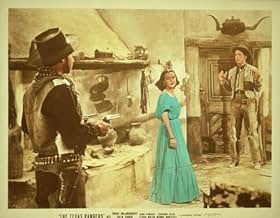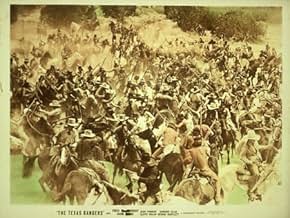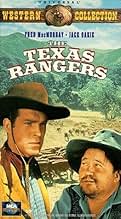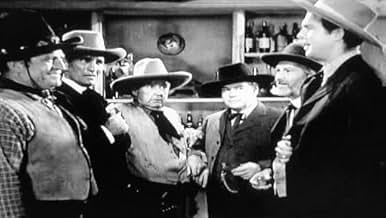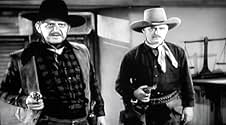ÉVALUATION IMDb
6,6/10
866
MA NOTE
Ajouter une intrigue dans votre langueTwo down-on-their-luck former outlaws volunteer to be Texas Rangers and find themselves assigned to bring in an old friend, now a notorious outlaw.Two down-on-their-luck former outlaws volunteer to be Texas Rangers and find themselves assigned to bring in an old friend, now a notorious outlaw.Two down-on-their-luck former outlaws volunteer to be Texas Rangers and find themselves assigned to bring in an old friend, now a notorious outlaw.
- Nommé pour 1 oscar
- 1 nomination au total
Benny Bartlett
- David
- (as Bennie Bartlett)
Fred Kohler
- Jess Higgins
- (as Fred Kohler Sr.)
George 'Gabby' Hayes
- Judge Snow
- (as George Hayes)
Stanley Andrews
- First Higgins Henchman
- (uncredited)
Irving Bacon
- David's Father
- (uncredited)
Kathryn Bates
- School Teacher
- (uncredited)
John Beck
- Stage Passenger
- (uncredited)
Hank Bell
- Hank Wallace, Texas Ranger
- (uncredited)
Virginia Brissac
- David's Mother
- (uncredited)
Histoire
Le saviez-vous
- AnecdotesKing Vidor made this movie to honor the celebrations of the centennial of the state of Texas.
- GaffesHawkins and the other Rangers are surrounded by Indians. He kills the 2 Indians rolling rocks, throwing his empty pistol at one. As he descends the other side, he mounts a bareback horse, riding off shooting a pistol that shouldn't be there as he rides away.
- Citations
Wahoo Jones: How do you expect to find Sam down in this country? Texas! Phooey! No towns, no ranch houses, no gals, no nuthin'. Hah! We can't see a jack rabbit in two days. Boy, you can't tell me we're still in the United States!
- ConnexionsEdited into Texas Rangers Ride Again (1940)
Commentaire en vedette
The Texas Rangers is directed by King Vidor who also co-writes with Elizabeth Hill, Louis Stevens and Walter Prescott Webb. It stars Fred MacMurray, Jack Oakie, Jean Parker and Lloyd Nolan. Music is by Gerard Carbonara and cinematography by Edward Cronjager. Plot has MacMurray and Oakie as two outlaws who decide to become Texas Rangers, something which invariably brings them into conflict with another outlaw pal.
It showcases the good and bad of 1930s Westerns. The action is strong and vibrant, the landscapes appealing and the story as a premise is always interesting. But those good points are countered with weak scripting, goofs, logic holes and a mixed bag of acting performances. But all told, Vidor's movie comes through its problems to stay firmly on the good side of good for the Western fan.
It's good guys versus bad guys on the home front, with the Indians lining up in numbers to be the common foe. It's here for the latter, where Vidor excels, constructing the action scenes with great skill as a ream of extras in Indian attire attack in their droves, arrows and bullets fly with murderous worth, bodies hurl and fall about, it's exciting stuff. The highlight coming as the Indians start flinging boulders off of a cliff face down onto the Rangers down below; the sound work here especially great, as is the stunt work in this whole segment of the film.
MacMurray and Oakie make a likable pair, but both seem a touch out of place in this portion of the Wild West. But Nolan cuts a nice snarly figure as chief villain Sam "Polka Dot" McGee, and he gets to deliver the film's best (nastiest) moment. Parker is pretty but pretty much a token, while secondary support slots are capably filled by the likes of Edward Ellis, Benny Bartlett and Frank Shannon. Cronjager's black and white photography is on the money, neatly utilising the New Mexico locations as wide open vistas that impose on the characters. While Carbonara scores it with standard Cowboys and Indian flavours for the attacks, and bombastic machismo for the Texas Rangers patrols.
Full of formula and mixed signals as to what it wants to be, The Texas Rangers is none the less an enjoyable picture and one of the better Oaters from the 30s. 7/10
Footnote: A sequel followed in 1940 called The Texas Rangers Ride Again. In 1949 The Texas Rangers was remade as Streets of Laredo, with William Holden starring.
It showcases the good and bad of 1930s Westerns. The action is strong and vibrant, the landscapes appealing and the story as a premise is always interesting. But those good points are countered with weak scripting, goofs, logic holes and a mixed bag of acting performances. But all told, Vidor's movie comes through its problems to stay firmly on the good side of good for the Western fan.
It's good guys versus bad guys on the home front, with the Indians lining up in numbers to be the common foe. It's here for the latter, where Vidor excels, constructing the action scenes with great skill as a ream of extras in Indian attire attack in their droves, arrows and bullets fly with murderous worth, bodies hurl and fall about, it's exciting stuff. The highlight coming as the Indians start flinging boulders off of a cliff face down onto the Rangers down below; the sound work here especially great, as is the stunt work in this whole segment of the film.
MacMurray and Oakie make a likable pair, but both seem a touch out of place in this portion of the Wild West. But Nolan cuts a nice snarly figure as chief villain Sam "Polka Dot" McGee, and he gets to deliver the film's best (nastiest) moment. Parker is pretty but pretty much a token, while secondary support slots are capably filled by the likes of Edward Ellis, Benny Bartlett and Frank Shannon. Cronjager's black and white photography is on the money, neatly utilising the New Mexico locations as wide open vistas that impose on the characters. While Carbonara scores it with standard Cowboys and Indian flavours for the attacks, and bombastic machismo for the Texas Rangers patrols.
Full of formula and mixed signals as to what it wants to be, The Texas Rangers is none the less an enjoyable picture and one of the better Oaters from the 30s. 7/10
Footnote: A sequel followed in 1940 called The Texas Rangers Ride Again. In 1949 The Texas Rangers was remade as Streets of Laredo, with William Holden starring.
- hitchcockthelegend
- 21 janv. 2012
- Lien permanent
Meilleurs choix
Connectez-vous pour évaluer et surveiller les recommandations personnalisées
Détails
- Durée1 heure 38 minutes
- Couleur
- Rapport de forme
- 1.37 : 1
Contribuer à cette page
Suggérer une modification ou ajouter du contenu manquant

Lacune principale
By what name was La légion des damnés (1936) officially released in India in English?
Répondre
